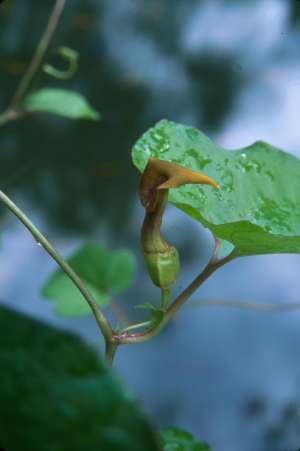Plants of South Florida · Plants by Conservation Area · Plants by County · Plants by Habitat Quick Search · Advanced Search |
||
|
|
||
 |
Aristolochia pentandra Jacq. Marsh''s dutchman''s-pipe |
|
|
South Florida Status: Critically imperiled. One occurrence at Biscayne National Park. Taxonomy: Dicotyledon; Aristolochiaceae. Habit: Perennial vine. Distribution: Native to South Florida and the West Indies. South Florida Distribution: Miami-Dade County and the Monroe County Keys. South Florida Habitats: Coastal rockland hammocks and coastal berms. Protection Status: Listed as endangered by FDACS and as critically imperiled by FNAI. Aids to Identification: & Correll (1982) has an illustration. References: Chapman, 1883; Small, 1933a; Pfeifer, 1970; Long & Lakela, 1976; Correll & Correll, 1982; Wunderlin, 1998; Coile, 2000. Synonyms: None. Historical Context: Abram P. Garber first collected Marsh’s dutchman’s-pipe in 1877 in Miami (1129a; F, GH, NA, US), presumably in Brickell Hammock. In 1913, John Kunkel Small and George K. Small collected it in a hammock between Miami and Coconut Grove (4634, NY). This collection was almost certainly from Brickell Hammock. In 1926, Small and others made the last collection on the South Florida mainland at what is now Deering Estate at Cutler (s.n., USF). Small and George V. Nash first collected Marsh’s dutchman’s-pipe in the Florida Keys in 1901 on Elliott Key (223, NY), in what is now Biscayne National Park. It has been collected three other times on Elliott Key, once by J.L. Fennell in 1939 (1046, UC), once by Frank C. Craighead in 1966 (s.n., FTG), and once by George N. Avery in 1978 (1823, FTG, USF). It has been observed on Elliott Key more recently by Roger L. Hammer in 1990 and 1996 (personal communication, 5 March 2001), and by Bradley and Woodmansee in 2001. The plants are primarily found on a coastal berm that runs along the eastern side of the island. Bradley and Woodmansee have collected geographical coordinates for the plants they have located on the island. In 1904, Nathaniel L. Britton collected Marsh’s dutchman’s-pipe on Soldier Key (335, F, NY), also in what is now Biscayne National Park. Small and Joel J. Carter subsequently collected it there in 1909 (3141, FTG, GH, NY, US). Bradley and Woodmansee surveyed this station in 2001, but no viable habitat for this species remains due to anthropogenic disturbances and rising sea level. In 1915, Small and Charles A. Mosier made a collection on Pumpkin Key (5674, MO, NY), a privately held island just outside of Biscayne National Park in Monroe County. Small and Mosier also made a single collection in 1912 in a hammock on Upper Matecumbe Key (3912, NY). This is the only known record for the middle Florida Keys. Major Threats: Exotic pest plant invasions, especially latherleaf (Colubrina asiatica); off-target damage from exotic species control efforts; sea-level rise. Comments: This species is a larval food plant for the polydamus swallowtail butterfly (Battus polydamas). The presence of a population of polydamas swallowtails on Elliott Key indicates that the population of Marsh’s Dutchman’s-pipe on Elliott Key may be larger than thought (R.L. Hammer, personal communication, 5 March 2001). Recommendations: • Survey Pumpkin Key and Upper Matecumbe Key. • Map and monitor known stations on a regular basis. • Control latherleaf and other exotic pest plants on Elliott Key. • Conduct conservation biology and conservation horticulture studies. • Consider establishing an ex situ collection of germplasm. • Consider reintroducing Marsh’s dutchman’s-pipe to other sites within its historical range, including Addison Hammock at the Deering Estate at Cutler. • Consider introducing Marsh’s dutchman’s-pipe to other sites within its historical range, including Alice Wainwright Park, Simpson Park, and Vizcaya Museum and Gardens within historic Brickell Hammock, and Attwood Addition, Indian Key Historic State Park on Upper Matecumbe Key. |
||



